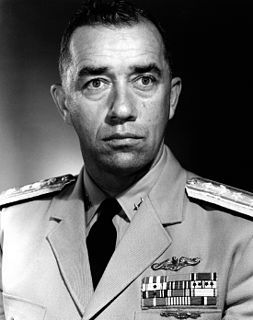John M. Burnham (September 11, 1917 – November 15, 1957) was the designer of USS Nautilus (SSN-571), the world's first operational nuclear-powered submarine.

USS Nautilus (SSN-571) was the world's first operational nuclear-powered submarine and the first submarine to complete a submerged transit of the North Pole on 3 August 1958.

Nuclear marine propulsion is propulsion of a ship or submarine with heat provided by a nuclear power plant. The power plant heats water to produce steam for a turbine used to turn the ship's propeller through a gearbox or through an electric generator and motor. Naval nuclear propulsion is used specifically within naval warships such as supercarriers. A small number of experimental civil nuclear ships have been built.

A submarine is a watercraft capable of independent operation underwater. It differs from a submersible, which has more limited underwater capability. It is also sometimes used historically or colloquially to refer to remotely operated vehicles and robots, as well as medium-sized or smaller vessels, such as the midget submarine and the wet sub.
He was a 1941 graduate of the United States Naval Academy. In 1947, he joined the Electric Boat Division of the General Dynamics Corporation at Groton, Connecticut. He became design manager at Electric Boat in 1952, and was responsible for the design of Nautilus and two other nuclear-powered submarines, USS Seawolf (SSN-575) and USS Skate (SSN-578).

The United States Naval Academy is a four-year coeducational federal service academy adjacent to Annapolis, Maryland. Established on 10 October 1845, under Secretary of the Navy George Bancroft, it is the second oldest of the United States' five service academies, and educates officers for commissioning primarily into the United States Navy and United States Marine Corps. The 338-acre (137 ha) campus is located on the former grounds of Fort Severn at the confluence of the Severn River and Chesapeake Bay in Anne Arundel County, 33 miles (53 km) east of Washington, D.C. and 26 miles (42 km) southeast of Baltimore. The entire campus is a National Historic Landmark and home to many historic sites, buildings, and monuments. It replaced Philadelphia Naval Asylum, in Philadelphia, that served as the first United States Naval Academy from 1838 to 1845 when the Naval Academy formed in Annapolis.

Groton is a town in New London County, Connecticut located on the Thames River. It is the home of General Dynamics Electric Boat, which is the major contractor for submarine work for the United States Navy. The Naval Submarine Base New London is located in Groton, and the pharmaceutical company Pfizer is also a major employer. Avery Point in Groton is home to a regional campus of the University of Connecticut. The population was 40,115 at the 2010 census.

USS Seawolf (SSN-575), a unique submarine, was the third ship of the United States Navy to be named for the seawolf, the second nuclear submarine, and the only US submarine built with a liquid metal cooled (sodium) nuclear reactor known as the Submarine Intermediate Reactor (SIR) or Liquid Metal Fast Reactor (LMFR), later designated S2G. Her overall design was a variant of Nautilus, but with numerous detail changes, such as a conning tower, stepped sail, and the AN/SQS-51 active sonar mounted in the top portion of the bow instead of further below. This sonar arrangement resulted in an unusual bow shape above the water for a U.S. submarine. Her distinctive reactor was later replaced with a standard pressurized water reactor, the replacement process lasting from 12 December 1958 to 30 September 1960.






